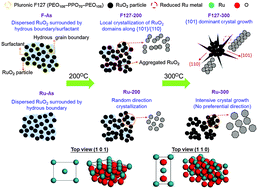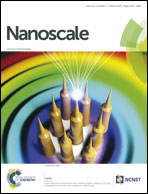Capacitive performance enhancements of RuO2 nanocrystals through manipulation of preferential orientation growth originated from the synergy of Pluronic F127 trapping and annealing†
Abstract
The capacitive performances of RuO2 prepared by oxidation precipitation of Ru precursors (RuCl3·xH2O) surrounded with tri-block co-polymer, Pluronic F127, in aqueous media can be enhanced through manipulating its preferential orientation growth of nanocrystals. From the heterogeneous surface chemistry viewpoints with the support of structure characterizations, such enhancement originates from the preferential orientation growth of the {101} facet due to the adsorption of the highly polarisable, non-ionic ligands of Pluronic F127 on the high surface energy facets on RuO2 nanocrystallites. In this case, the F127-trapped sample with annealing at 300 °C enhances the specific capacitance 1.6-fold in comparison to its counterpart without F127. With the mechanistic insight into the heterogeneous surface crystal growth pathways, our results materialize the development of RuO2 with tuneable capacitive performances. Furthermore, due to the different propagation models of RuO2 with and without F127 trapping, a schematic diagram is proposed to interpret such a unique crystal growth evolution phenomenon.


 Please wait while we load your content...
Please wait while we load your content...